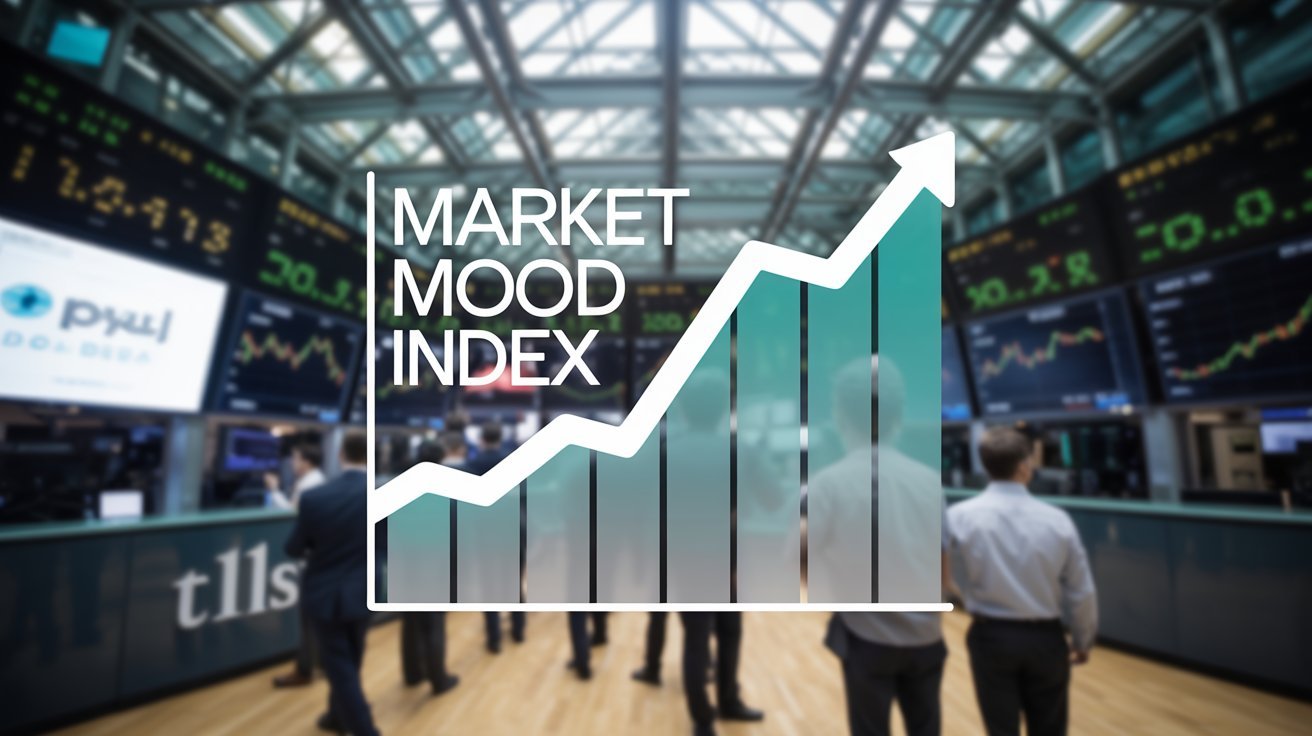Market Mood Index: What It Means for Your Investments Today

The Market Mood Index is a simple way to understand how investors feel about the stock market right now. When the market mood index is high, it shows people are excited and confident, but when it’s low, it means they are worried or cautious. This mood can change quickly, and knowing it helps you make smarter choices about when to buy or sell.
By watching the market mood index, you get a snapshot of the overall feeling in the market, like a weather report for your money. It helps you see if others are feeling hopeful or fearful, which can affect prices and trends. Learning to use the market mood index can give you an edge to protect your investments and find good opportunities.
What Is the Market Mood Index and Why It Matters
The market mood index is a tool that helps show how investors feel about the stock market at any moment. It tells if people are excited and confident or worried and cautious. Knowing this feeling can help you decide when it might be a good time to buy or sell stocks.
This index looks at many signals from the market, such as price changes and trading volumes, to create a number or score. This score gives a quick picture of the overall market mood. If the score is high, it means people feel good about the market, but if it’s low, people may be afraid to invest.
Investors use the market mood index to understand the market better because feelings can affect prices a lot. When many people feel happy, they might buy more, pushing prices up. But when they feel scared, they might sell, causing prices to drop. So, this index helps you follow these moods.
By paying attention to the market mood index, you get a better idea of the right time to act. It’s like knowing the weather before going outside. If you check it, you can avoid big surprises in the market and protect your money.
How the Market Mood Index Reflects Investor Feelings
The market mood index shows how investors feel, whether they are hopeful or worried about the future. It measures things like fear and greed in the market. These emotions often guide what buyers and sellers do every day.
When investors are greedy, they tend to buy more stocks, expecting prices to go higher. The index rises during these times. But when fear takes over, many investors sell to avoid losses, and the index falls. This emotional cycle can create ups and downs in the stock market.
Understanding these feelings helps investors make smarter choices. Instead of just guessing, they can see what most people feel and plan their moves better. The market mood index acts like a mood ring for the stock market.
Remember, the feelings of many people can drive prices more than actual news. So, paying attention to the market mood index gives you a powerful way to read the market’s heartbeat.
Easy Ways to Read the Market Mood Index
Reading the market mood index doesn’t have to be hard. Usually, it is shown as a number or graph that changes daily. You can find it on finance websites or apps that track the stock market.
If the number is high, it means most investors are feeling positive. A low number means they are worried or cautious. The index usually has a middle point that shows a neutral mood when investors are neither too happy nor too scared.
You can use the market mood index to spot chances to buy stocks at a good price. For example, when the index is very low, many people might be scared, and prices could be cheaper. This might be a good time to invest if you believe the market will improve.
By checking the index often, you learn how moods change over time. This helps you avoid following the crowd blindly and make better decisions for your money.
Market Mood Index vs. Other Market Indicators: What’s Different?
Many people use different tools to understand the stock market, but the market mood index is special because it focuses on feelings, not just numbers. Other indicators look at things like company earnings or economic reports.
For example, the price-to-earnings ratio shows if a stock is cheap or expensive based on profits. But it does not show how investors feel right now. The market mood index fills this gap by showing if people are nervous or confident.
This difference makes the market mood index very helpful. It tells you when emotions might be pushing prices up or down too much. If the market mood index is very high, prices could be too high because of excitement. If it’s very low, prices might be too low because of fear.
Using the market mood index together with other tools gives you a full picture. It helps you see not only the facts but also how people’s feelings shape the market.
How to Use the Market Mood Index for Smarter Investing
Using the market mood index can make your investing smarter and safer. When the index is very high, it might be a warning that people are too excited, and prices could fall soon. In these moments, it might be wise to be careful or sell some stocks.
On the other hand, when the index is very low, it can mean that people are too scared. This could be a chance to buy good stocks at lower prices before the market improves. Learning to read this mood can help you buy low and sell high, which is the goal of investing.
Investors can also combine the market mood index with their own research about companies. This helps them avoid decisions based only on emotions and get better results in the long run.
Tips for using the market mood index:
- Check the index regularly to see market changes
- Avoid making quick decisions based only on emotions
- Use it with other information like company news and earnings
- Remember that no tool is perfect, so always be careful
What Changes the Market Mood Index? Key Factors Explained
The market mood index changes because of many things that affect how investors feel. Big news about the economy, politics, or companies can quickly change moods. For example, if a country has a problem, investors might get scared and the index falls.
Other important factors include interest rates, inflation, and earnings reports from companies. When these are good, people feel better and the market mood index goes up. When they are bad, the index drops as investors become worried.
Sometimes, moods change without any big news. This happens because investors watch each other and follow trends. If many people start selling, others may join even if nothing new happened. This can make the index go down fast.
Understanding these reasons helps you know why the market mood index moves. It shows that feelings, news, and actions all work together to shape the market.
When Should You Trust the Market Mood Index?
The market mood index is a helpful guide, but it is not always perfect. Sometimes the mood might change too quickly or not show the full story. It’s important to use it as one tool among many.
You should trust the market mood index more when it agrees with other signs, like good company results or strong economic data. When many tools say the same thing, it’s a stronger signal.
When to be careful with the index:
- During sudden news shocks that create panic
- When the market is very uncertain or unusual
- If the index moves without clear reasons
By learning when to trust the index and when to be cautious, you get better at protecting your money and spotting good chances.
Real-Life Examples: Market Mood Index in Action
To see how the market mood index works, let’s look at some real examples. During the 2020 pandemic, many investors felt very scared. The market mood index dropped a lot as people sold stocks fast.
But after some time, the index slowly went up because investors started feeling hopeful again about recovery. Those who watched the index saw chances to buy stocks at low prices and made good profits later.
Another example is during big political events like elections. The market mood index can jump or fall quickly depending on the news. Watching the index helps investors avoid surprises and plan better.
These examples show why the market mood index is a useful tool to understand what others feel and make smarter investment moves.
How the Market Mood Index Can Help You Avoid Big Losses
The market mood index is useful to protect your money. When the index shows fear, it means many people are worried and might sell their stocks. This can cause prices to drop quickly.
By paying attention to the index, you can prepare for these times and avoid losing too much money. Sometimes, it’s better to sell some stocks or wait before buying more.
Ways the market mood index helps avoid losses:
- Alerts you when the market is too excited and risky
- Shows when fear might cause prices to drop too much
- Helps you make calm decisions, not emotional ones
Using this index helps you stay safer in the ups and downs of the market and keeps your investments strong for the future.
Conclusion:
The market mood index is like a mood meter for the stock market. It helps you see if investors feel happy or worried. Knowing this can help you decide when to buy or sell your stocks. It’s a simple way to understand the big feelings that move the market every day.
By watching the market mood index, you can avoid surprises and make smarter choices with your money. Remember, it’s not perfect, but it is a helpful tool that works best when used with other information. Keeping an eye on it can keep your investments safer and help you find good chances to grow your money.
FAQs:
Q: What is the market mood index?
A: It is a tool that shows how investors feel about the stock market, like happy or worried.
Q: How does the market mood index help investors?
A: It helps investors decide when to buy or sell by showing the overall mood of the market.
Q: Where can I find the market mood index?
A: You can find it on many finance websites or apps that track stock market data.
Q: Is the market mood index always right?
A: No, it’s helpful but not perfect. It works best when used with other information.
Q: Can the market mood index predict market crashes?
A: It can give clues by showing fear or excitement but cannot predict crashes for sure.




